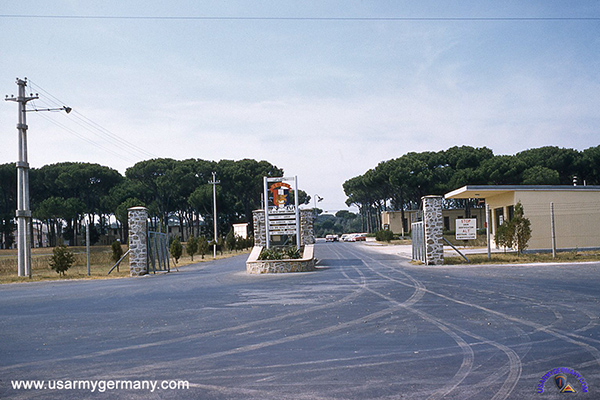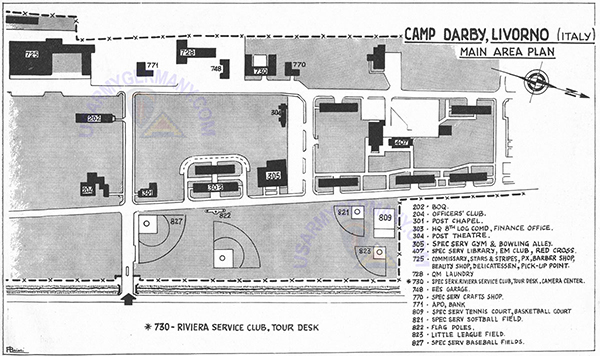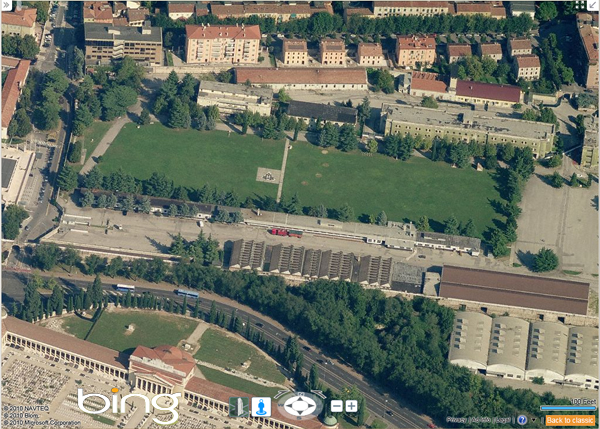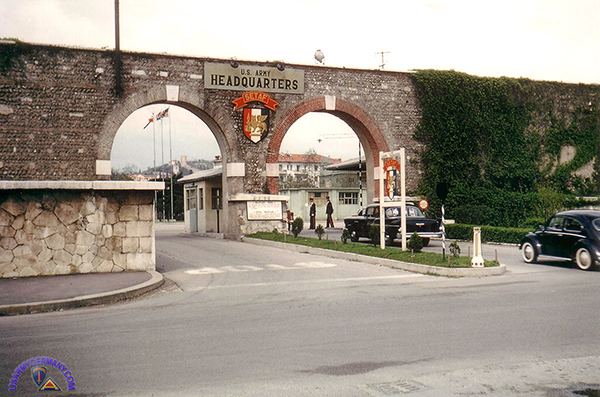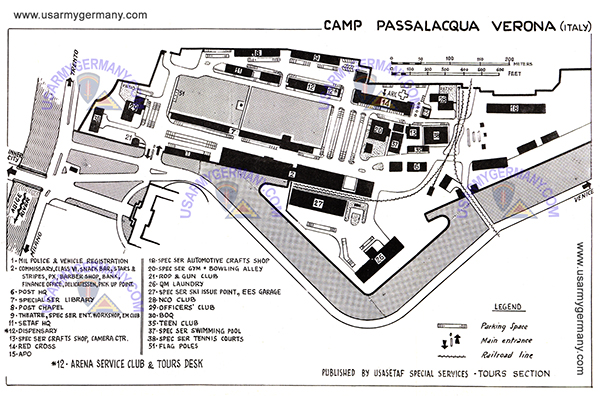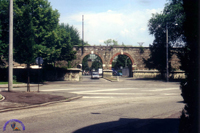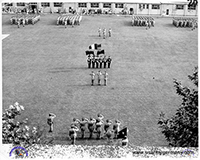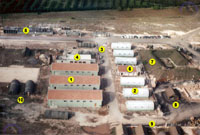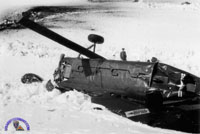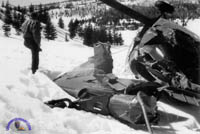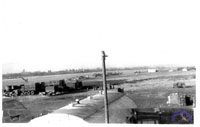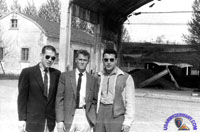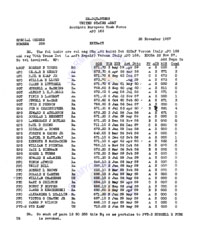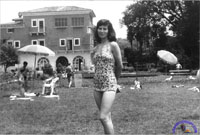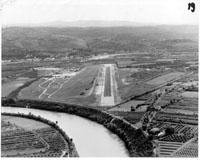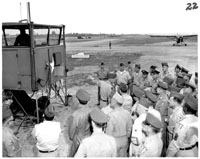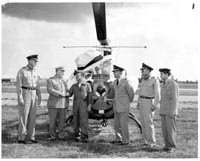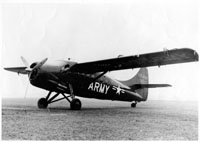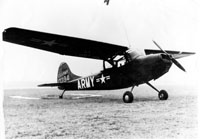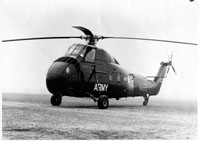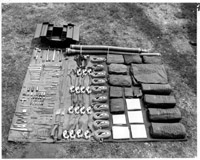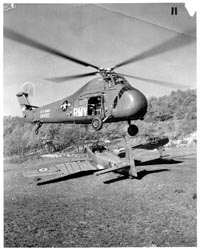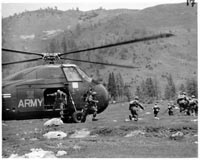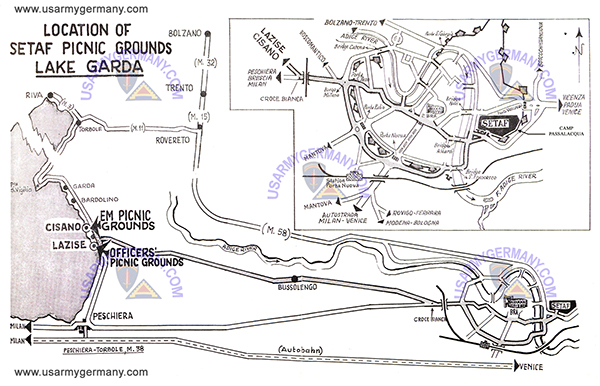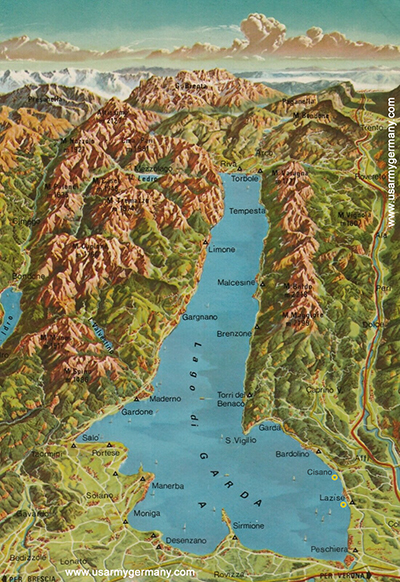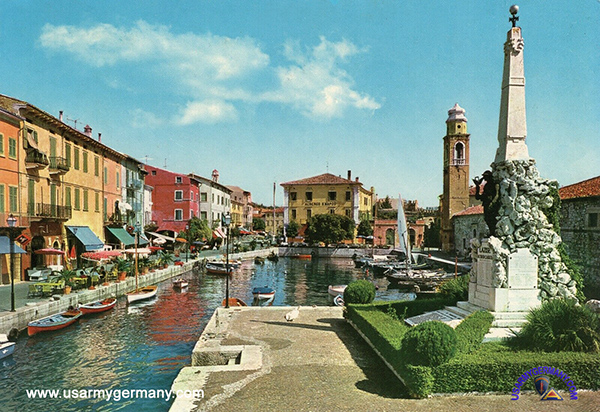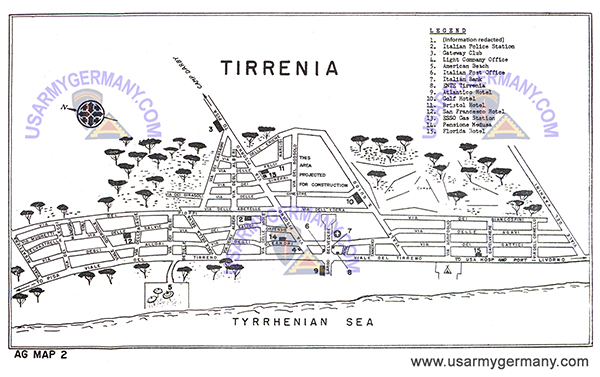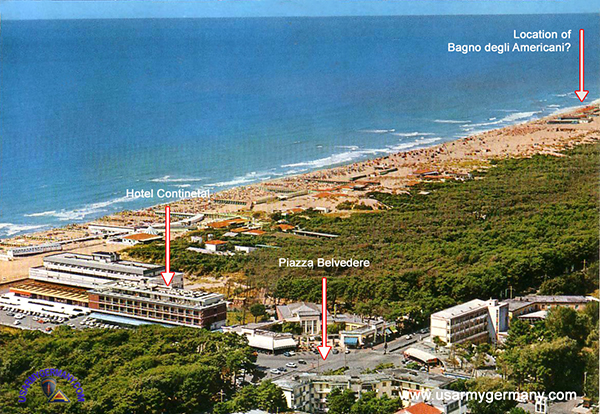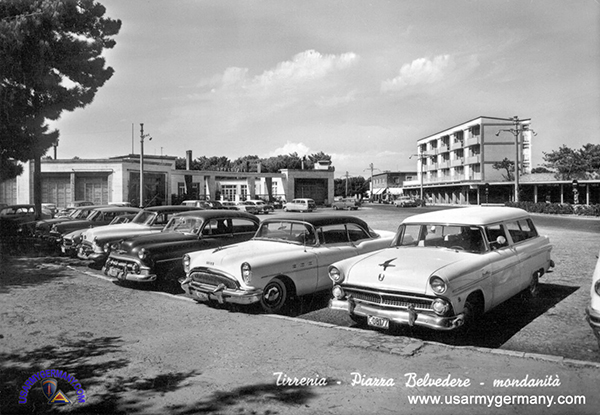| If you do NOT see the Table of Contents frame to the left of this page, then Click here to open 'USArmyGermany' frameset |
|||||||||
SETAF Installations |
|||||||||
|
|
|||||||||
|
|||||||||
|
|
|||||||||
| History of SETAF Installations | |||||||||
| 1956 | |||||||||
| (Source: STARS & STRIPES, Sep 1, 1956) | |||||||||
| Italy Construction Saving $16 Million. SETAF Employs the Economy for the Sake of Economy VERONA, Italy, Aug. 31 (Special) -- SETAF's engineers, working with the local Office of the Joint Construction Agency, are saving American taxpayers an estimated $16 million in construction costs for U.S. Army facilities here. A free rein in dealing with the immediate market and reversion to rehabilitation, where possible, are effecting the hugs savings. The $16 million represents the difference between SETAF's authorlzed expenditures for construction -- $27 million -- and the amount actually being spent. Three modern Army installations are being constructed in the Veneto region of northern Italy. The work is "reconstruction," in part, since the new camps will be located on the grounds of ancient Italian "casermas" and will carry the names of their forerunners, Casermas Chinotto and Ederle in Vicenza will be the home of many SETAF troops, while SETAF Hq and most staff sections will be located In Verona's Caserma Passalacqua. The construction-rehabilitation projects are contracted to local firms. Billions of Italian lire are pouring into the regional economy since the entire corps of laborers and all materials come from the local market. At the time of SETAF's activation in October 1955, the Department of the Army authorized $27 million for the construction of SETAF Hq and the three installations. This figure included costs which were to be spread over two fiscal years, 1956 and 1957. Even before the Joint Construction Agency could organize the letting of contracts, members of the 532nd Engr Co in Vicenza picked up their hammers and went to work. Such initiative on the part of all members of the command has characterized the rapid and economical progress already made. Initial construction and rehabilitation were temporarily halted last winter because of heavy snow and cold weather. Work commenced again in early spring and has continued at full speed through the summer. Early operatlons completed included the SETAF Hq building and the post theater. Before long many other buildings and roads will receive their finishing touches Early September Estimated completion dates include early September for the two enlisted men billets and the dlspensary at Passalacqua. Rehabilitation of the dependent school in Vicenza is also due to be completed in September, just before the fall term starts. Central heating in all buildings is due to become operational on or about Nov. 1. Construction of a quartermaster gas station, laundry, bakery and cold storage plant should be start ed soon. The EM and Officer messes and a permanent bachelor officers quarters also are in the planning stage. Later, a flight strip near Passalacqua and additional post exchange facilities and crafts and entertainment shops will fill the schedule. Even a half-mile railroad track will be laid, connecting the Verona casern with the Italian lines. Comparable costs of construction -- using the most economical local material which meets structural and functional requirements -- for the U.S. and Italy shows that a large saving can be made by using Italian-produced material. |
|||||||||
| Camp Darby, Livorno (Leghorn) | |||||||||
| (Source: Livorno Site Information, DoD SITES) | |||||||||
| In June of 1951, The United States and Italy concluded negotiations to establish a line of communication and supply through Italy, in support of troops in Austria. Tnder the agreement, Italy provided the land and the United States began construction of a military post, a general depot and a port which were to be the basic facilities for the logistical command. The military complex, located between Pisa and Livorno, waw formerly dedicated on 15 November 1952. It was named Camp Darby in memory of Brig Gen William O. Darby, Assistant Division Commander of the 10th Mountain Division, who was killed in action on 30 April 1945 in Trento, Italy. Since its establishment. Camp Darby has served successively for the 7656th Logistical Command, the 7617th USFA Support Command, USA Logistical Command (sic), 8th Support Group, and currently the 22nd Area Support Group. As US occupation forces in Austria were withdrawn after the Austrian State Treaty was signed in 1955, Camp Darby was the base for the removal of soldiers, equipment and supplies from Austria. With Austria neutral, northern Italy’s eastern flank became vulnerable to attack. To reduce the danger in that area, the U.S. agreed to establish a force there; and, on October 25, 1955, the U.S. Army Southern European Task Force was activated. USASETAF’s first headquarters was on Camp Darby, but the largest number of soldiers has always been in Vicenza. Shortly after activation, USASETAF moved the headquarters to Verona, to Caserma Passalacqua. Troop strength reached 10,000, and USASETAF was formally established with a U.S.-Italian agreement. |
|||||||||
| U.S. Army Hospital, Leghorn | |||||||||
| 1970 | |||||||||
| (Source: USAREUR Medical Bulletin, February 1970) | |||||||||
| The US Army Hospital, Leghorn is operated by the Third Hospitalization Unit, 45th Field Hospital. The hospital is located on the northern outskirts of Leghorn, Italy, at Calambrone, a point on the seaside road, Via Del Tirreno, which connects the cities of Leghorn and Pisa.
Begun at Leghorn in 1952, this small hospital is authorized an operating bed capacity of 25 beds. Since 1957, the hospital has been housed in a leased permanent-type building which was originally designed as a boy's school. The medical facilities of the hospital are modern and well-equipped and include two operating rooms and one delivery room, one large ward, nursery, hospital clinics, pharmacy, laboratory, radio graphic section and dental clinic. The enlisted barracks as well as all administrative services are located within the one hospital building. The hospital provides area medical support to US Army, Navy and Air Force personnel, Department of the Army civilians, State Department personnel and authorized dependents in an area from La Spezia to Florence to Rome. This includes the Mediterranean Division Corps of Engineers in Leghorn and port calls by the Sixth Fleet, US Navy. The facility also provides medical care to authorized foreign personnel and emergency medical care as required. |
|||||||||
| (Source: USAREUR Medical Bulletin, February 1970) | |||||||||
| ASSIGNMENT IN ITALY MAJ Raymond H. Cherrington, Jr., ANC Learning of a European assignment, both pleased and distressed me. I looked forward with great expectations to a two-year European tour, but I felt anxious about how I would be able to communicate with foreign people, and how I would contact my new unit. Then the welcoming letter arrived from the command ing officer informing me that the unit I was assigned to was a small 25-bed hospital located near Leghorn, Italy. So I relaxed and started to wonder what it would be like to work in Sunny Italy. Upon arrival, I was confronted with what appeared to be total devastation of what was to be my future duty station. The kitchen part of the dining hall was located adjacent to the dining hall; however, it was now operating in a tent. The former two operating rooms were undergoing reconstruction, and what had been the delivery room was currently the operating room. A patient’s room was the new location for the delivery room, while the Central Materiel Section had been relocated in a large 12-bed ward. I looked at the dust, dirt and dislocation of these prime hospital units and shook my head in utter disbelief! Then, with an expression of bewilderment, I asked “Is this the US Army Hospital, Leghorn?” and noted the amused expression on the faces of my future fellow workers when they answered, “Of course.” Then, slowly, a gleam appeared as they realized my initial shock at the appearance of the building. They quickly explained “This is only temporary because of needed repairs on the roof. The repairs and remodeling will be completed in a few weeks, then all should return to normal.” The “reporting day” seems long ago. During the construction period we were able to practice “field mass casualty and dislocation nursing.” We had problems, but we managed to live through them. The operating room was a challenge, but we were given a free hand in making necessary changes. In a small hospital, nurses soon learn the importance of cross-training and getting along with each other. No one can afford to consider himself strictly a specialist. We soon realized that regardless of our in dividual specialties, we had to provide relief where needed. During the chief nurse’s absence, I found myself sitting behind her desk, making decisions which affected the entire nursing service. One of the ward nurses is being trained to take calls in the operating room. When the chief nurse is not in her office, she can be found in the Outpatient Department assisting the doctors. Since we have no Army health nurse, a staff nurse has volunteered to give classes to expectant parents. Regardless of her military occupational specialty (MOS), every nurse performs medical, pediatric and obstetrical nursing. We have our busy and our lax periods. We learn to adapt, cooperate and to fill in wherever we are needed. We get away from our own area of special interest, and gain insight into the problems of other specialties. We profit professionally and personally as we learn additional skills and acquire a deeper understanding. The important point is that we are essential members of the medical service team providing medical care to the military, their dependents and other American citizens in an isolated area. |
|||||||||
|
|
|||||||||
| Caserma Ederle, Vicenza | |||||||||
|
|
|||||||||
| Caserma Chinotto, Vicenza | |||||||||
| Caserma Passalacqua, Verona | |||||||||
| 1958 | |||||||||
Can anybody provide more details on locations of US and NATO facilities in and around Verona, incl. installation maps, photos, etc.? Also interested in location of the recreation facility (beach) on Lake Garda that was reserved for US use in the 1960s. |
|||||||||
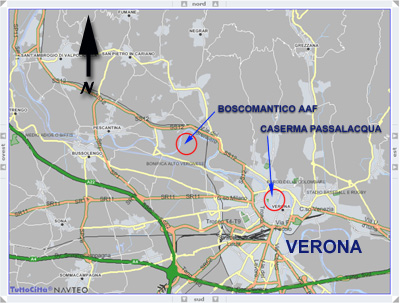 |
|||||||||
(Source: Email from Malcolm Comeaux) |
|||||||||
You asked that I send you photos of Passalaqua. I have only two. The first one was taken in the summer of 1958 (see above photo), when Passalaqua was a U.S. Army base. The second one was taken in the summer of 1997. At that time (1997) the Italian military used the right side as you entered the gates, and on the left side was the University of Verona. ( (Also read Malcolm's email regarding Boscomantico Airfield.) |
|||||||||
(Source: Email from William Hansen, 98th Sig Bn and 202nd Trans Co (Lt Hel)) |
|||||||||
|
|||||||||
| 1962 | |||||||||
(Source: Email from John Browning, 163rd MI Bn, 1962-64) |
|||||||||
I was stationed at Camp Passalacqua in Verona, Italy from Feb. 1962 to Sept. 1964. My unit was the 163d Military Intelligence Battalion, which morphed into the 430th MI Detachment during my stay.
I kept a diary during my growing-up years, and in 2002 I published a book named "Flint Hill" which was basically an autobiography covering the first 24 years of my life. About one-third of the book (which, believe it or not, is 1800+ pages long) dealt with my three-year Army enlistment, most of which was spent at Camp Passalacqua. Anyone interested in reading my book can contact me. It's listed on AMAZON.COM., among other places. I note that you're looking for further info on the "former American beach" on Lake Garda. When I was there, the Officers' Rec Center was located in the village of Lazise ( John Browning
ADDITIONAL INFORMATION I was an enlisted man stationed at Camp Passalacqua in Verona, Italy from Feb. 1962 through Sept. 1964. My unit was the 163d Military Intelligence Battalion, which was "downsized" into the 530th MI Detachment during my tour of duty there. Other units at Passalacqua included Headquarters Company, 560th Signal Battalion, 68th MP Company, and 57th Army Postal Unit. At the army airfield at Boscomantico, several miles outside the city, were 110th Aviation, 17th Transportation, and an Air Force unit, 5th ATAF. The facilities at Passalacqua included a PX, snack bar, library, commissary, Class VI store, and movie theater. Those poor guys stationed at Boscomantico had to ride military buses into Passalacqua to use these services. Most units fielded teams in softball, basketball, volleyball, and football which competed against one another. At the end of each sports season, there were playoffs to determine the post champion, which went on to compete against the champions of Camp Ederle and Camp Darby for the SETAF championship. Other recreational activities included the alerts which were called each month, and the "field problems," which came up every three months and lasted about a week. One of my most vivid memories of Verona is of the dense fogs which would roll in, suddenly and unexpectedly, usually in the fall and winter. I recall once walking from our barracks to the snack bar on a perfectly clear night, and by the time I finished my snack and left, the fog had rolled in, and I got lost in the parking lot between the snack bar and barracks. A running joke was that you could go to the latrine on a sunny day, and by the time you finished and came out, the fog would be so thick you couldn't see your hand in front of your face. (Webmaster note: Can anybody locate the exact locations of the two American Rec Centers/beaches at Lazise and Cisano?) |
|||||||||
1965 |
|||||||||
(Source: SETAF Dispatch, Oct 26, 1965) |
|||||||||
|
|||||||||
|
|
|||||||||
| Boscomantico AAF, Verona | |||||||||
1957 |
|||||||||
(Source: Email from Malcolm Comeaux) |
|||||||||
I was stationed at Boscomantico ( |
|||||||||
|
|||||||||
When this photo was taken, there is also an addition being built to the rear of the latrine -- that was to be our shower area. To provide water pressure for the showers, a large water tower was soon built behind and to the right of the mess hall (about where a bomb crater is seen), along the edge of the river terrace, and as far from the runway as possible. Until the water tower was completed, we had to go into Verona to Passalaqua to take showers. The large tent (8) at the lower right, surrounded by black, was the motor pool. A motor pool building is being built to the right of the tent. The motor pool had nice facilities before a hanger was built. There are three tents (9) seen in the immediate foreground. The second from the left held specialized tools for working on aircraft, and one night in the winter of 1959 there was a spectacular blaze when it burned to the ground, and all the tools were lost. One man from my unit lived in the tent, but he got out safely. Two Jamesways (10) are seen on the left and behind the large buildings. The first was our “day room” and it held a piano, a pool table, a refrigerator, and a few chairs. When Capt. Reese told us to load the piano in a deuce-and-a-half and take it to the dump, we instead took it to a local bar we called “mamas” and placed it in the basement. It may still be there. The main road to the base came in from the upper right, near where the cars are parked.. |
|||||||||
(Source: Email from William Chakeres, US Army Avn Det & 70th Trans Det, 1957-58) |
|||||||||
I understand your interested in obtaining additional information regarding the "American Beach", which was located in
a rented millionaires villa, in Cisano on Lake Garda. I was stationed with the "US Aviation Detachment" at that time -- housed in Castelnuovo which is halfway between Verona and the lake. Our aircraft were maintained at Villa-Franca airport which now serves Verona. We later moved from Castelnuova to Boscomantico, where we were re-assigned as the 70th Transportation Det. I have some pictures taken at the lake along with a copy of the orders reassigning our unit as the 70th. There were approximately 35 of us in the unit, when the orders were cut on 11/26/57. |
|||||||||
1958 |
|||||||||
(Source: STARS & STRIPES, Sept 2, 1958) |
|||||||||
A joint Italian-American ceremony marked the opening of the 3,300-foot runway at the new airport at Boscomantico. The SETAF airfield, which will cost $372,000 when completed, will be used by the US Army and by the Verona Aero Club. |
|||||||||
(Source: Email from William Hansen, 98th Sig Bn and 202nd Trans Co (Lt Hel)) |
|||||||||
I was stationed in Verona, Italy, in 1958 - late 1959 with the 98th Signal Battalion, Camp Passalacqua, Verona, and then at Boscomantico Airport with the 202nd Army Aviation and Transportation Co. I have many photos of Campo Passalacqua and Boscomantico Airport, also all the aircraft that we used and old pix of the airport and pix of the airport after it was modified.
|
|||||||||
1960 |
|||||||||
(Source: Email from Dave Anderson, 110th Avn Co, 1960-62) |
|||||||||
I see you have an e-mail posted by a Richard Young. While I didn't remember him our paths on the post must have crossed a number of times. I was stationed in Boscomantico from 1960-1962. When I got shipped to Italy, they weren't sure where I belonged. Went to Verona for about a week and then they sent me to Camp Ederle, Vicenza. I was assigned to the 110th Aviation Company. Spent a couple of months there and then the entire unit was sent to Boscomantico where we joined the 202nd Transportation Company. They built a new barracks building and we were the first to occupy - very nice. Had a mess hall and snack place on the first floor and a PX and barbershop in building right next door, but most facilities were at Camp Passalaqua in Verona, which was the major post for SETAF then. Eventually the two companies merged to form the 1st Combat Aviation Company (Provisional) and was that way when I left. Since I worked in the Orderly Room with usually late hours I often couldn't make the hourly bus that went to main post at 5PM and took an hour getting there. So I spent a lot of time at the Italian Aeroclub across the runway. We shared the airfield with them. Had a small bar there, probably enough for 6, and was run by a German girl, Honey, and her assistant was an Italian girl with a name sounding like Ume. Honey was was married to an Italian and lived right behind the club. I was there when "Barabbas" (Anthony Quinn) was being filmed. Only remember one soldier, SP4 Gentile from the Recon Platoon who worked on that move as an extra. He was probably the best looking of the soldiers at the post. I met Aldo Ray at the PX in Passalaqua. My 1st Sgt Anger also married an Italian girl from Verona -- a nurse. Best wedding reception I ever attended -- three complete courses and much wine. Attending the opera at the Arena was among the most memorable experiences of my life. We had an Enlisted Men's recreation area at Lago de Garda where we went frequently in season and rode the airboats on the Lake to Riva del Garda. Years later, one of my nephews, Career Army, became Commander of the post at Vicenza. Don't remember exactly when but must have been in the late 1990's. He told me then that Camp Passalaqua had only a minor role and he didn't even know about Boscomantico airport so guess somewhere along the way the U.S. Military pulled out. (Webmaster note: I am looking for more details about the former American beach on Lago di Garda. I know that it was in use at east in the 1950s and early 1960s. Went there several times as an Army brat. But don't know where exactly it was located.) |
|||||||||
1961 |
|||||||||
(Source: Email from Richard Young, Det 1, 7th WS, Boscomantico) |
|||||||||
I was stationed in Boscomantico from Oct 1961 to Feb 1965. I was in the USAF, Detachment 1, 7th Weather Squadron, a small detachment of the Air Weather Service assigned to provide weather support for the Army aircraft (U1A's and Hueys primarily) that flew from Bosco. I came to know a lot of Army guys along with the guys in my own unit. Being single (I was just 19, wide-eyed and clueless when I got there) I lived in the barracks, a two story building with the mess hall in one end and a snack bar in the other with a day room across the hall from it. The Army post commander was Major Gilroy, though I think he rotated out before I left. I don't remember who his replacement was. Our Air Force commander was first a Major Grisham, and he was replaced with a Major Stein.
A few of the army personnel that I can recall were Tom McNally (he was an air traffic controller and my pinochle partner), Sam McGill ( air craft maintenance), 'Lucky' Gorham (I remember he was from Texas, as was Sam McGill), Steve "Schlermie" Schulman from NYC who would get a big kosher sausage stick from home every Christmas, and Johnny Kidd from Georgia. Many other faces are fixed in my memory, but the names elude me. Some guys in my unit were George Gall from MI, Roland Bremer from Louisiana, Sterling Nicholson who used to rave about the great duty at Myrtle Beach, Joe Markham from Virginia, Ray Howell from D.C., et. al. We would work 2 days in the station and 2 days in the tower, unless extraordinary circumstances required otherwise, as when the Vaijonte dam disaster occurred and choppers from Bosco flew rescue missions. There is a picture on your website that shows the "new" portable control tower. We took our weather observations from that tower - I recognize it - until they put in a new permanent tower about 40 feet high. There was a civilian bar called the Aero Club across the runway where we would often go. A pretty German blonde we called 'Honey" and her Italian husband whose name I never knew ran the place. Many a G.I. went reeling across the runway back to the barracks from that place after a night of indulgence. I'd like to get in touch with anyone who might have been there during my hitch. The only reason anyone might remember me was that I was, as I said, in the Air Force. We Air Force guys were, you might say, 'the turd in the punch bowl' and thereby, perhaps in someway, remembered. If you can suggest any way for me to find any of the Bosco guys, I would appreciate it. thanks. |
|||||||||
1965 |
|||||||||
(Source: Email from Peter Mutascio) |
|||||||||
From February 1965 to August 1967 I was assigned to the US Hospital Unit, 45th Field Hospital, Medical in Verona, Italy. We were part of SETAF. I was wondering what brigade, group or command we fell under. Webmaster response: The 45th Field Hospital reported directly to the Surgeon's Office, Headquarters SETAF. I was in Verona when this came out. Later at the aid station at Boscomantico. Flight Surgeon and two medics. In 1966 Passalacqua was downsized, most everyone and all facilities except for the dispensary and MP's stayed. At that time we had two MD's and a dentist. Then moved over to a building by the QM Laundry. I rotated back in 1967. Bosco was still open until 1969 (?). Then closed and reopened in the early 70's with the 509th Airborne (arriving from Mainz, Germany) then it closed again, now abandoned. A comment on that open house picture at Passalacqua: I was there that day. John Browning made a post and a few years later we became friends, he passed on a few years ago during Covid. Do have some pictures of Passalacqua and Bosco, some are mine, others from the Net. |
|||||||||
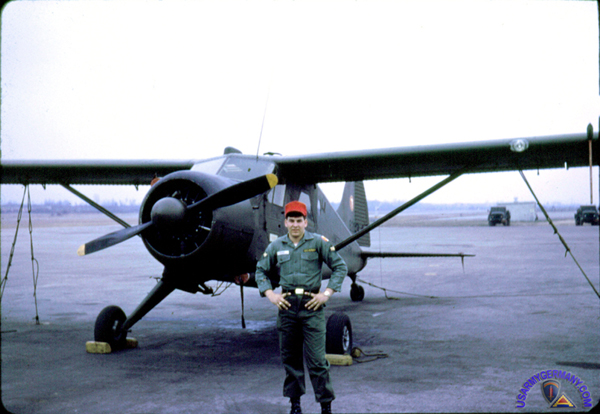 Dave Dinges, 17th Trans Det (AAR), Bosco Airfield, 1968 |
|||||||||
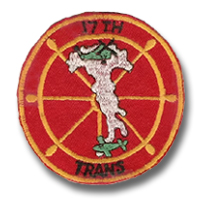 17th Transportation Detachment (AAR) Patch (courtesy David W. Dinges, Jr.) 17th Transportation Detachment (AAR) Patch (courtesy David W. Dinges, Jr.) |
|||||||||
1968 |
|||||||||
(Source: STARS & STRIPES, March 16, 1968) |
|||||||||
17th Transportation Detachment (Army Aviation Repair) The 17th Trans Co is located at Boscomatico AAF, near Verona, Italy. CO of the unit is Capt Robert E. Fear. The 17th provides maintenance support to all aircraft assigned to SETAF as well as any aircraft belonging to Military Assistance Groups located in Iran, Turkey, Greece, Ethiopia and the Republic of the Congo. This includes recovery of disabled planes and helicopters. The unit operates one fixed-wing plane, a U-6A BEAVER, that is utilized for hauling repair parts and to transport personnel to and from machine shops. Three of the unit's officers are pilots. |
|||||||||
| Lake Garda Recreation Area, Verona | |||||||||
1956 |
|||||||||
(Source: Email from Chet Gillis) |
|||||||||
I stumbled on the website and have many great memories of Verona and the lake. I also have many slides of Cisano, Peschiera, Verona the Campo and have returned to visit twice, once in 1999 and then again in 2002. The gardens at Cisano were manicured when I was there in 56/57, they were a run down mess when I visited there in 2002. When I was stationed there, we had a Riva mahogany speed boat to water ski behind daily. The overnights cost 50 cents and the beer 15 cents a can, the mixed drinks were fifty cents. I worked in the com center on the top floor of SETAF headquarters as a teletype trick chief operator/repairman. We worked two twelve-hour days twice with two days off for each shift and then a three day twelve on twelve off and three days off. We spent much of the off time at Cisano and Venice/Lido in the summer. Winter months were spent in Milano and skiing in Cortina or drinking Verona dry.. I think you could call it a year and half in paradise. |
|||||||||
1966 |
|||||||||
(Source: STARS & STRIPES, Aug 8, 1966) |
|||||||||
SETAF offers recreation areas at Lake Garda and Leghorn (Livorno). Lake Garda, near Verona, has an officers' recreation area at Lazise and an enlisted men's area at Cisano. Leghorn has a beach for all ranks. All offer sumer recreation at no cost. European Exchange System (EES) snack bars sell beer, ice, soft drinks, steaks, hamburgers and hot dogs. The Lake Garda areas have villas and at Cisano single enlisted men may have free rooms. At Lazise officers and their families may obtain rooms at low cost. The SETAF recreation areas open May 29 and are scheduled tentatively to close Sept. 11. (See email from William Chakeres, US Army Avn Det & 70th Trans Det, 1957-58, for a photo of the enlisted men's villa at Cisano in the late 1950s) |
|||||||||
| Tirrenia Recreation Area, Pisa | |||||||||
Related Links: |
|||||||||
|
|

